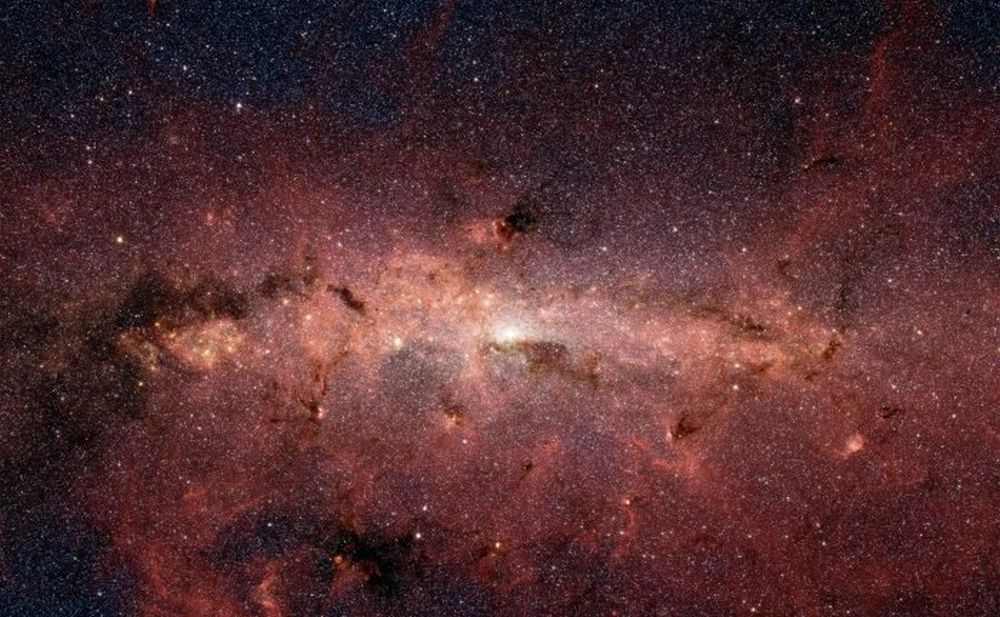Globular clusters (GCs) are spherical groups of stars held together by mutual gravity. Large ones can have millions of stars, and the stars tend to be older and have lower metallicity. The Milky Way contains more than 200 globulars, possibly many more, and most of them are in the galaxy’s halo, the outer reaches of the galaxy.
But they’re not all in the halo, and astronomers are keen to find ones nearest the galactic centre. Now, researchers have found one GC that’s plunging toward the Milky Way’s Centre. Astronomers use globular clusters as a way to probe the machinations of the Milky Way.
GCs are long-lived, but in tumultuous regions like the galactic centre, their long-term survival is threatened. Dynamic friction can eat away at the gravitational bonds that hold globular clusters together. There’s been an ongoing effort to find GCs near the center to learn more about GCs and more about the galactic centre.
The VVV (VISTA Variables in the Vía Láctea) survey is a European Southern Observatory effort to locate star clusters in the Milky Way’s bulge. In a 2020 paper , researchers working with data from VVV found the closest GC to the Milky Way’s centre: VVV CL002. In a new paper involving some of the same researchers, astronomers found that VVV CL002 is plunging toward the center of the Milky Way.
The paper is “ The globular cluster VVV CL002 falling down to the hazardous Galactic centre. ” The lead author is Dante Minniti of the Andrés Bello Catholic University in Santiago, Chile. The paper will be published in the journal Astronomy and Astrophysics.
Powerful tidal forces dominate the Milky Way’s centre. Astronomers think that globulars that get too close to the centre are torn apart, their stars scattered into the general population of crowded stars. But astronomers are struggling to come up with a realistic model to explain it.
By finding surviving GCs in the galactic centre, researchers hope to understand the region and GCs better. VVV CL002 is the closest GC to the center. It’s only 0.
4 kpc (1300 light-years) away. But it’s moving toward the center very quickly, at about 400 km s ?1 . VVV CL002 has an eccentric orbit that takes it from 619 to 3,400 light-years from the centre.
Its orbit is tighter to the centre than any other known GCs. As it orbits, it’s moving closer to the galactic centre. It’s also counter-rotating.
These are all clues to its origins and its fate. Its orbit, location, and motion mean that VVV CL002 can’t have formed anywhere near where it is today. “No globular cluster is expected to survive over its lifetime (>10 Gyr) in such proximity to the Galactic centre,” the authors explain.
But there’s more to this research than location, movement, and velocity. Those alone don’t give astronomers the full picture of where the GC came from, which is clearly an important question. To answer this, the researchers turned to metallicity.
Stellar metallicity refers to the abundance of elements heavier than hydrogen and helium in a star or group of stars. Older stars typically have lower metallicity, while more recently formed stars typically have higher metallicity. The researchers were able to measure the metallicity by focusing on target stars in the globular cluster.
Astronomers often compare the iron content of a star to its hydrogen content to express its metallicity. An FE/H value of 0 is what our Sun has. If the value is lower than that, in the negatives, it means the subject has lower metallicity than the Sun.
If the value is above 0, the subject has a higher metallicity than the Sun. The researchers found that the stars in VVV CL002 have a mean metallicity of -0. 54, meaning it has a low metallicity.
That’s a signal that the stars are old. What does this all add up to? “This confirms that VVV CL002 is an old globular cluster formed together with other clusters and field stars present today in the Galactic bulge rather than a younger open cluster or the remains from an (already-disrupted) dwarf galaxy,” the authors write. So VVV CL002 didn’t form where it is today.
The metallicity measurements are in line with stars that formed within 3 to 6 kpc (~10,000 to 20,000 light-years) of the galactic centre. “This brings us to a scenario where VVV CL002 was formed at a relatively large R birth and started to fall towards the centre recently,” the researchers write in their conclusion. For VVV CL002, the future is immutable.
It’s heading straight for the galactic centre, and nothing can stop it. And the galactic centre is not a hospitable place. Among other hazards, the supermassive black hole Sagittarius A* holds court there, and everything in its vicinity dances to its gravitational tune.
As the nearest GC to the galactic centre, VVV CL002 can teach astronomers a lot. “This cluster sheds light on the intriguing survival and migration mechanisms of globular clusters, whereas many less-characterized globular clusters and candidates are within a couple of kilo-parsecs from the centre,” the authors explain. Follow-up studies are needed to untangle some of those lessons.
But they can be difficult to acquire in the crowded region of the galactic centre. “Demand is high for near-infrared high-resolution spectroscopy of such clusters, which has been handicapped due to severe interstellar extinction ,” Minitti and his co-researchers explain. Wherever it came from and how exactly it formed, VVV CL002 is headed for destruction.
“It is probably doomed to continue spiralling into the inner parsecs and be destroyed in the not-so-distant future,” the researchers write. .
From: universetoday
URL: https://www.universetoday.com/165064/this-globular-cluster-is-plunging-toward-the-milky-ways-centre/



